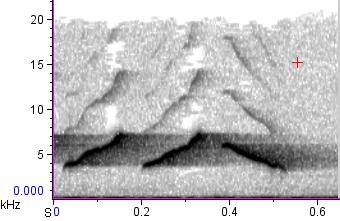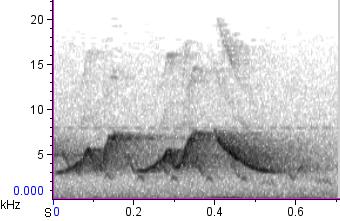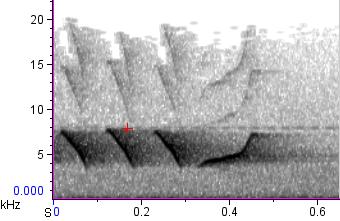I was walking down the sidewalk in downtown Yellowknife in June when I heard this song (![]() Audio)--a sweet "Please-please-please-ta-meetcha". To a birder skilled in identifying eastern North American birds by their songs, this could normally mean only one thing… the presence of a male Chestnut-sided Warbler.
Audio)--a sweet "Please-please-please-ta-meetcha". To a birder skilled in identifying eastern North American birds by their songs, this could normally mean only one thing… the presence of a male Chestnut-sided Warbler.
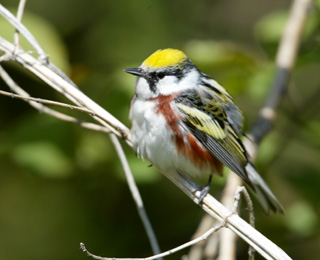
Chestnut-sided Warbler
Credit: John Kormendy
That's what I would have thought if I was back home in Maine, but one thing you quickly know when travelling to far away locations is that your expectations are often wrong. So I picked up my binoculars and zoomed into the birch tree from where the song had come. A Chestnut-sided Warbler appears essentially white on its underside which is the side of the bird of which you often get the best view. The white accentuates the blood-red (some would call the color "chestnut") stripes that run down the sides of the breast.
Instead, what I saw was a pure yellow bird with reddish stripes across its brilliant yellow undersides---an unmistakable male Yellow Warbler.
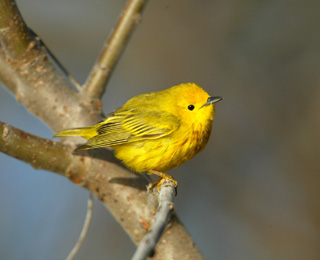
Yellow Warbler
Credit: John Kormendy
Every Yellow Warbler I heard sing in the Yellowknife area over the next few days---and I heard lots as they are very common there---sang a virtually identical song to that first one. In other words, the Chestnut-sided Warbler type song was typical, not an anomaly.
To illustrate the similarity of these Yellowknife Yellow Warblers to a typical primary Chestnut-sided Warbler song listen first to this Chestnut-sided Warbler I recorded in Augusta, Maine in July 2009. Remember that the song is typically rendered as "please please please ta meetcha." (![]() Audio)
Audio)
Here is a sonogram of the song (basically a graph of the sound frequency over time—higher notes are closer to the top). You can see that the song has four distinct descending notes followed by two notes that rise abruptly and one that descends abruptly—this is the "ta meetcha" part of the song.
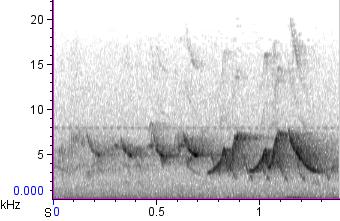
Now here is the typical song of a Yellow Warbler from the northeast U.S. which is typically rendered as "sweet-sweet-sweet, I'm so sweet" or some variation of that. This is one I recorded in Augusta, Maine in July 2009. (![]() Audio)
Audio)
Here is a sonogram of the song which shows 5 distinct checkmark like notes, followed by four rapid descending notes and the final sharply ascending note. These last five notes are the "I'm so sweet" part of the song though in this case it could be better rendered as "I'm so su-gar sweet." Notice the song's abruptly rising ending note unlike the descending final note in the Chestnut-sided Warbler song.
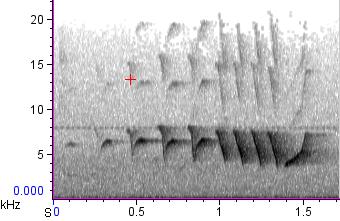
Finally, listen to this typical song of the Yellow Warbler I heard around Yellowknife, Northwest Territories and compare it back to the Chestnut-sided Warbler song. This was recorded just north of Yellowknife in June 2009. (![]() Audio) In the sonogram below of this song you can see three descending notes followed by three rising notes and a final abruptly descending note giving it the "ta-meetcha" ending like a Chestnut-sided Warbler.
Audio) In the sonogram below of this song you can see three descending notes followed by three rising notes and a final abruptly descending note giving it the "ta-meetcha" ending like a Chestnut-sided Warbler.

Just for comparison sake I clipped out the final notes of each of the three sonograms to show them side by side. I am still amazed at how similar the Yellowknife Yellow Warbler is to the Maine Chestnut-sided Warbler and how different it is from the Maine Yellow Warbler.
Yellowknife Yellow Warbler ending:
Maine Chestnut-sided Warbler ending:
Maine Yellow Warbler ending:
In doing a little reading about Yellow Warbler songs, I was not able to find anything about this song variant, but I did some searching of Cornell's Macaulay Library of Natural Sounds and discovered a clip recorded in northern Quebec in 1953 by famed pioneering bird sound recorder and Cornell ornithology professor Dr. Arthur Allen in which a voice at the end of the cut (presumably Dr. Allen's) describes how the Yellow Warbler in question is switching between a more normal song and a Chestnut-sided like song.
Click here to listen to the recording.
If anyone out there has any more knowledge about the song types of northern Yellow Warblers and how prevalent the type of song I heard in Yellowknife is within northern Yellow Warblers, please add your comments below!


